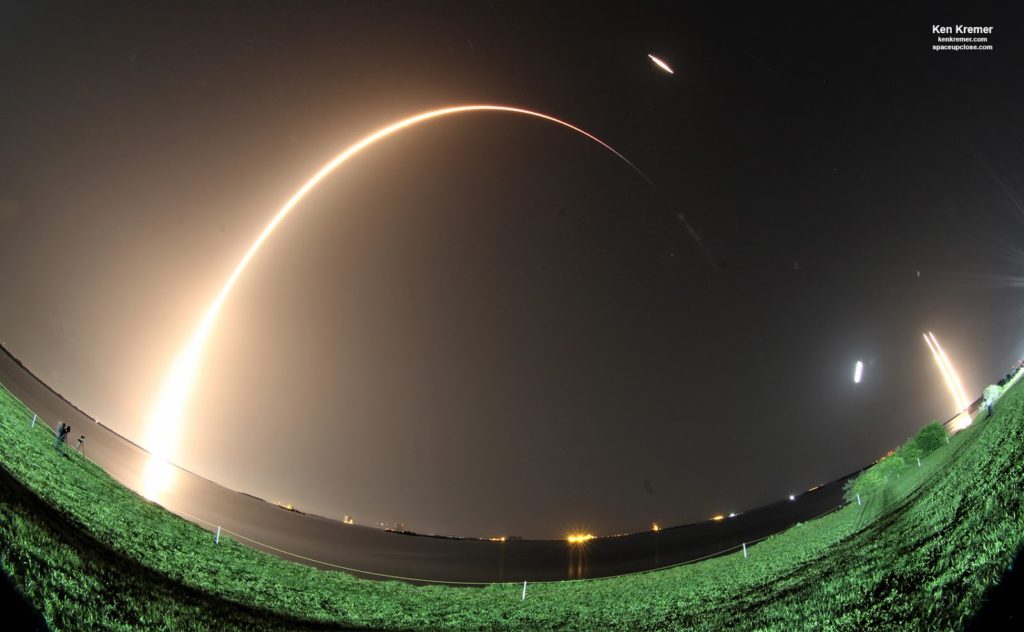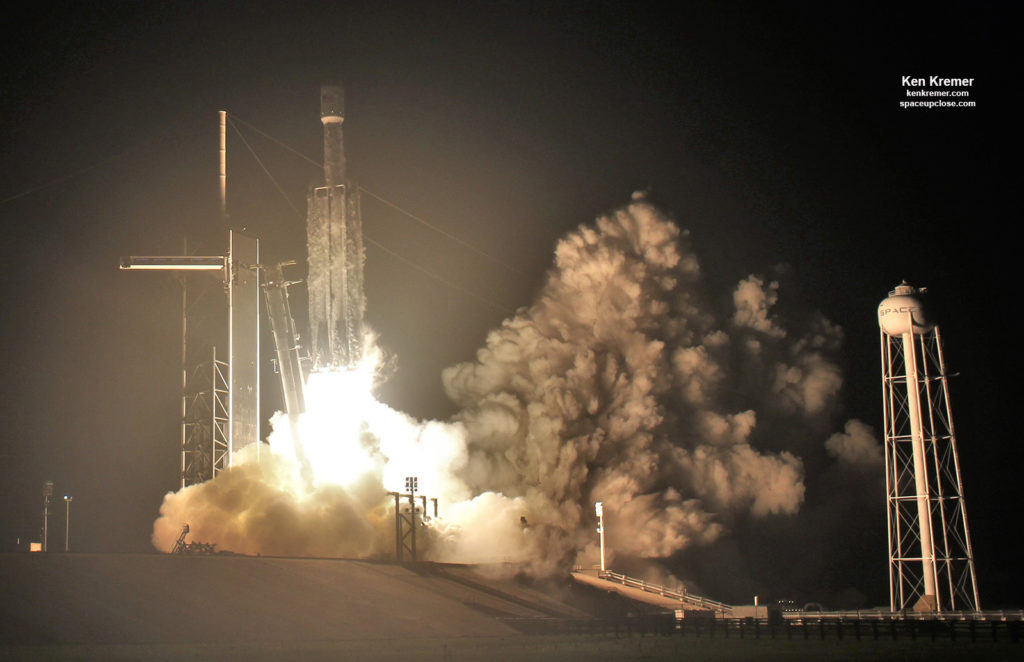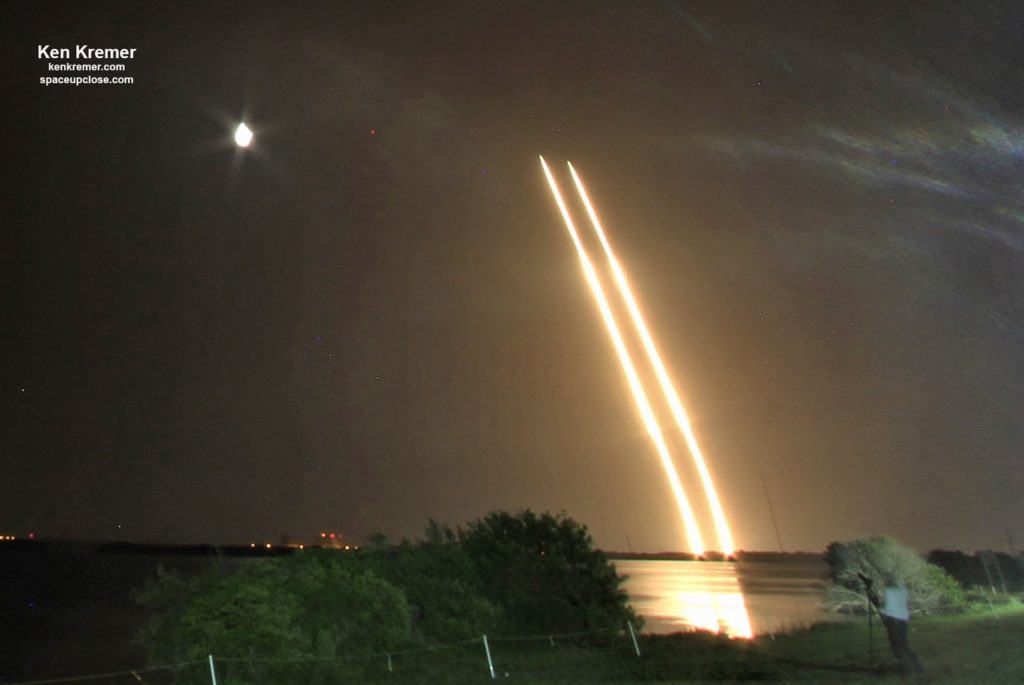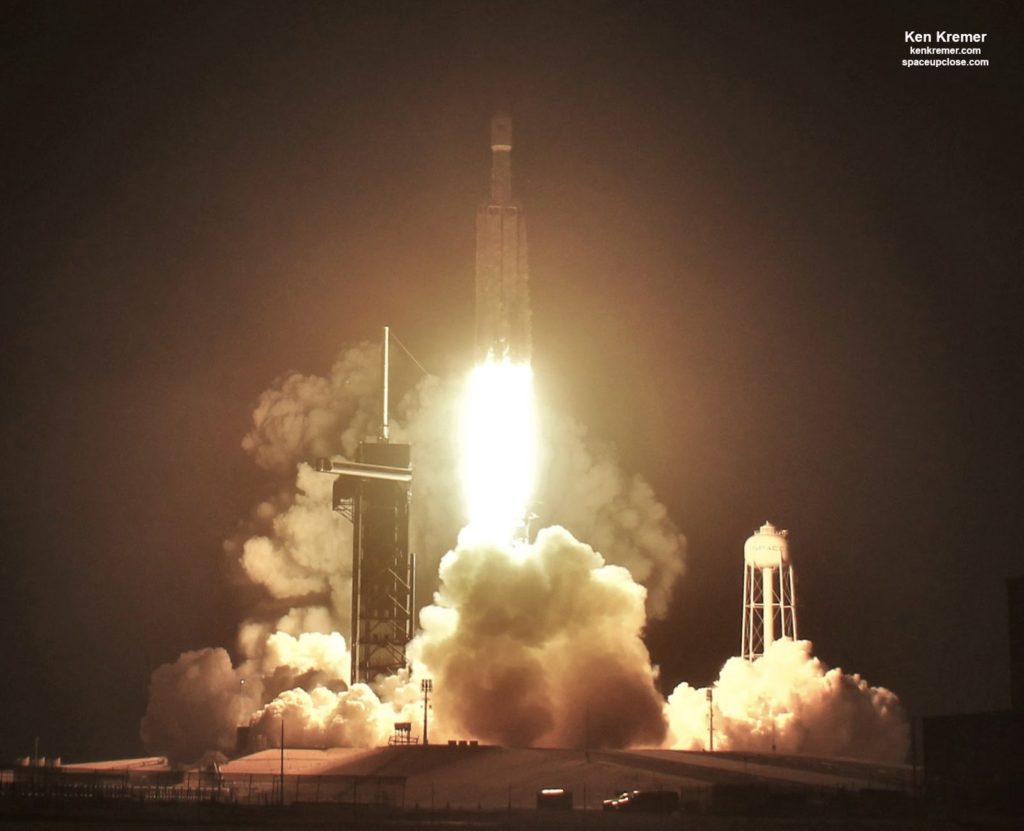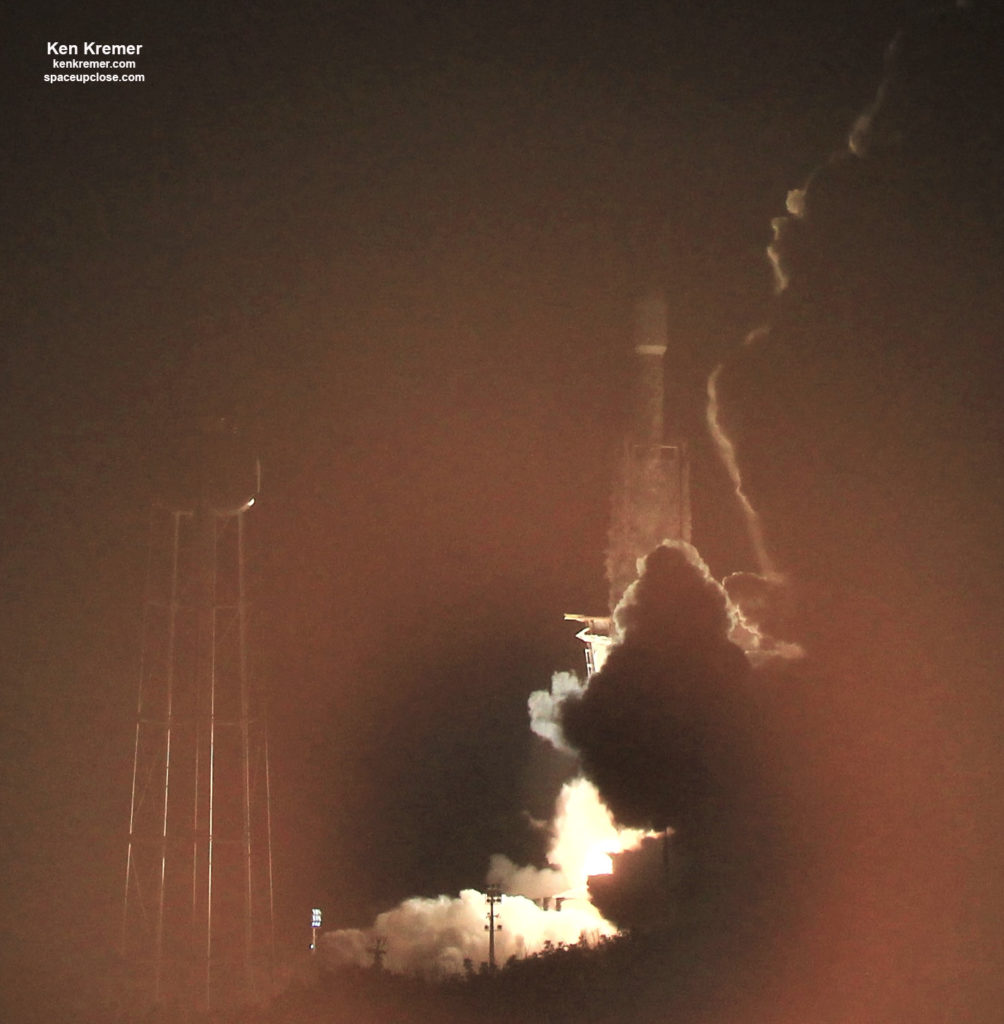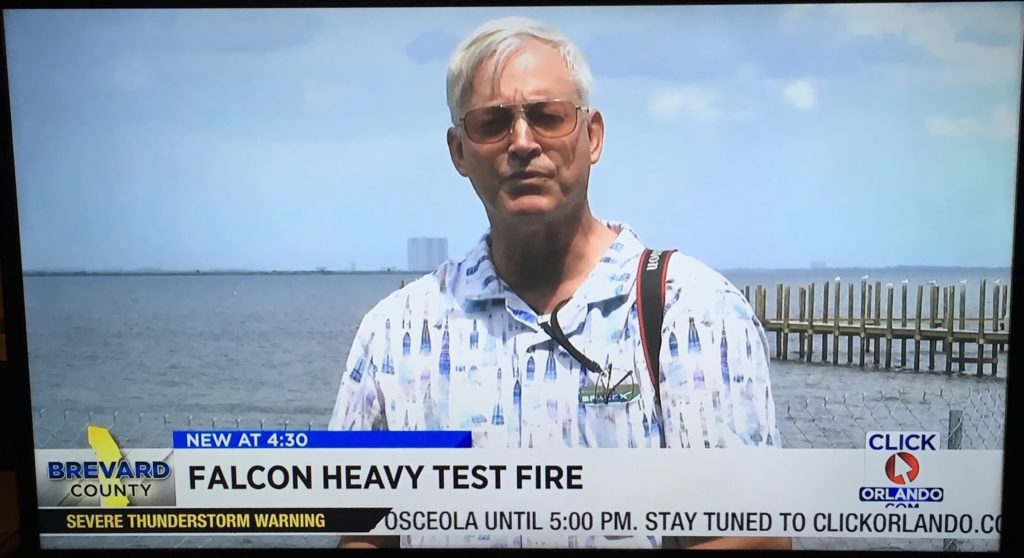Kremer — SpaceUpClose.com &
RocketSTEM – 25 June 2019
KENNEDY SPACE CENTER, FL – 24
science satellites streaked to orbit during an absolutely spectacular middle of
the night liftoff this morning Tuesday, June 25, 2019, on the first night
launch of the 23 story tall triple stick SpaceX Falcon Heavy program that also featured the
first ever fairing catch by the special boat at sea and twin land landings of
the twin side boosters minutes later – on the most complex mission ever for SpaceX
says CEO Elon Musk.
Following a nail biting three hour delay to
fix ground support equipment liftoff of the Space Test Program-2 (STP-2)
mission for the U.S. Air Force finally took flight at 2:30 a.m. EDT
June 25, 2019 from Launch Complex 39A at the Kennedy Space Center in Florida.
of Defense (DoD) and managed by the U.S Air Force Space
and Missile Systems Center (SMC) with NASA as a
partner.
“This launch was a true partnership across
government and industry, and it marked an incredible first for the U.S. Air
Force Space and Missile Systems Center,” said Jim Reuter, associate
administrator for NASA’s Space Technology Mission Directorate.
“The NASA missions aboard the Falcon Heavy also
benefited from strong collaborations with industry, academia and other
government organizations.”
And what a wallop it was.
Shortly after ignition of all 27 Merlin 1D first
stage engines a blaze of fire spewed from the engines and literally that turned
night into day from one moment to the next.
And the crackling roar of the engines
shuttered across the Cape delighting tens of thousands of spectators who
gathered from across the globe for the first ever night launch of the SpaceX Falcon
Heavy that evolved into a middle of the night launch due to the 18 minute
postponement that pushed the launch from 11:30 PM Monday evening to 2:30 AM EDT
Tuesday morning.
Enjoy our gallery of Space UpClose imagery ringing
KSC and the launch pad.
Check back as the gallery grows.
off the pad. No.
the twin side boosters separated as the center core continued firing and illuminated
the exhaust plume.
of colored light for a few brief and stunning seconds. See our photos.
it wasn’t – just the engine flames lighting up the rocket vapor trail and as
the side booster began their boost back burns.
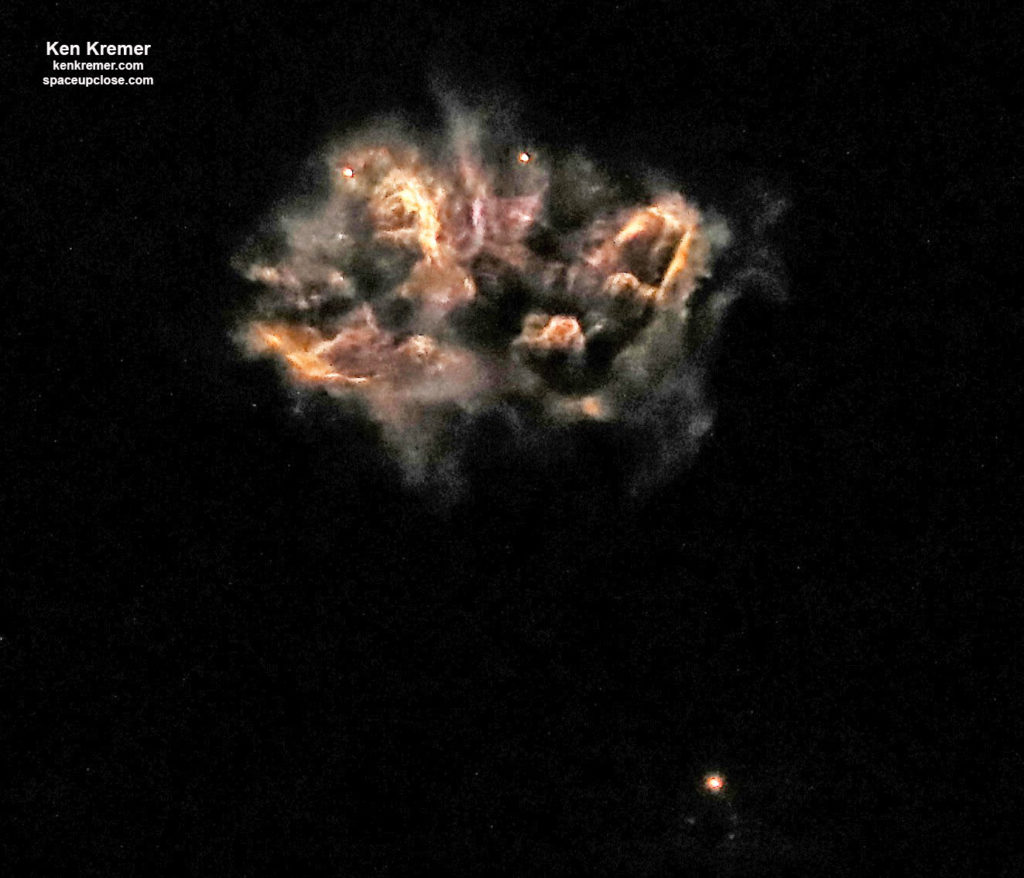 |
|
Credit:
Ken Kremer/kenkremer.com/spaceupclose.com |
at 3 min and 31 seconds after launch.
entry and landing burns.
their plummet to Earth they passed through the sound barrier just a few hundred
feet above ground and sent a multitude of bone rattlingly loud sonic booms
screaming across the Space Coast region and beyond.
awoken and babies started crying – locals told Space UpClose.
at sea on the OCISLY droneship. It crashed into the ocean just beside the
droneship
overall – was the first one to utilize recycled rockets. The side boosters were
recycled from the last Falcon Heavy launch in April 2019 on the Arabsat 6A mission.
upright and intact back at the Cape at Landing Zones 1 and 2 or LZ-1 and LZ-2: eight
minutes and 41 seconds after liftoff.
image) and up close – focused on the twin side landings below on Cape Canaveral
Air Force Station.
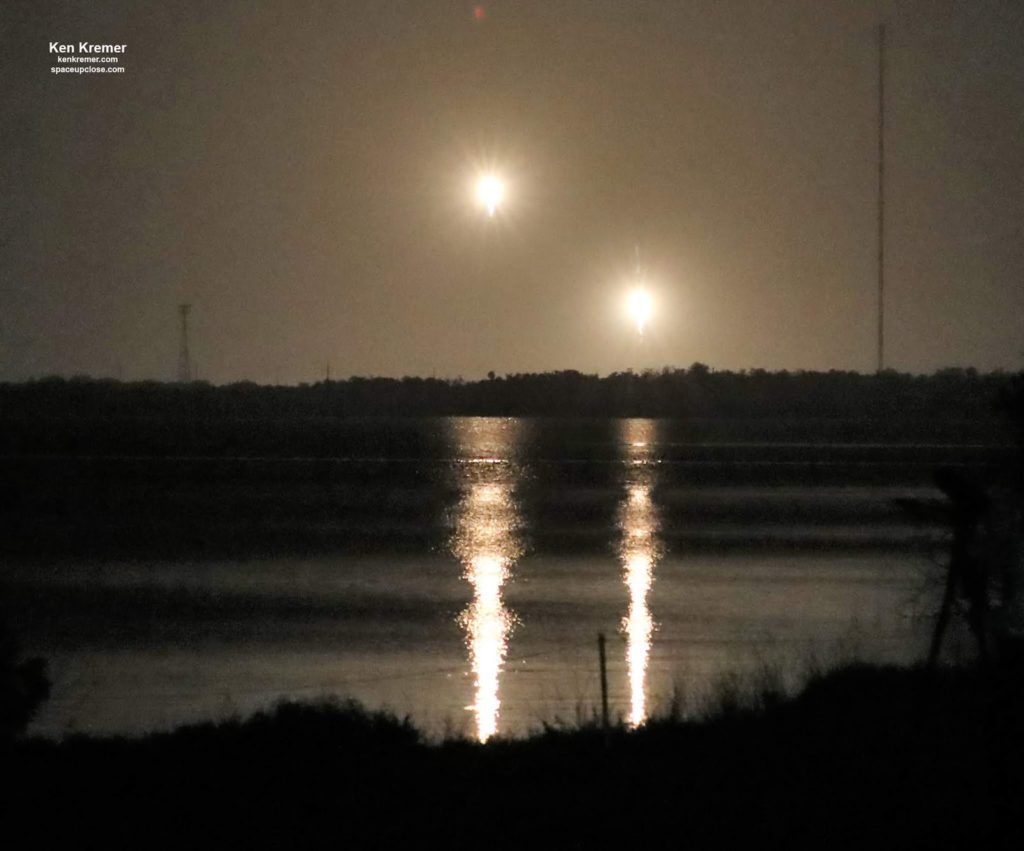 |
| Dual side core boosters land back at Cape Canaveral after launch of triple core SpaceX Falcon Heavy on June 25, 2019. Credit: Ken Kremer/kenkremer.com/spaceupclose.com
|
The mission was ordered by the U.S. Air Force
and is the “most difficult launch ever” for SpaceX says SpaceX CEO and
billionaire founder Elon Musk.
STP-2 is the first ever Falcon Heavy mission for the DOD and
includes science, research and military research and technology payloads for
the US Air Force as well as four satellites for NASA, six satellites for NOAA, also a number for Universities, Industry and
one for the Planetary Society and human ashes too.
The triple stick Falcon Heavy successfully deliver 24 science,
research, technology development and military research satellites to space into
3 separate orbits and inclinations as the second stage was fired for a record 4
separate times in another test scoping out the range of its capabilities.
Furthermore the mission duration for the 4 second stage
engine firings to enable the 24 satellite deployments is a record breaking 6
hours.
communication, the Air Force Space & Missile
Systems Center said.
of 24 satellites aboard the Falcon Heavy was successful! Thank you &
congratulations to our partners on a successful mission!” tweeted the Air Force Space & Missile Systems about 12 hours after liftoff.
contact!”
With the dispenser that rises to 5000 kg.
investigating technologies that will help improve future spacecraft design and
performance in space.
Space Test Program-2 flight include:
interplanetary navigation that could change how we navigate on the Moon, to
Mars and beyond,
four experiments to help will reveal the ways local space weather affects
spacecraft hardware,
green propulsion system could
take the small satellite revolution beyond what it is today, and
that interfere with GPS and communications signals.
sponsoring the Constellation Observing System for Meteorology Ionosphere &
Climate-2, or COSMIC-2 system– a
constellation of 6 satellites. They will orbit 322 miles above Earth with a
mass of 250 kg.
The Falcon Heavy first stage is comprised of
three Falcon 9 cores. The center core is new and plumbed differently from the twin
pair of side cores – which are recycled from the Arabsat 6A launch in mid-
April.
tall and 39.9 feet (12.6 m) wide with a mass of 3,125,735 lb
(1,420,788 kg).
launch at News 6 Orlando here:
for liive coverage of the SpaceX Falcon Heavy STP-2 launch.
onsite coverage of NASA, SpaceX, ULA, Boeing, Lockheed Martin, Northrop Grumman
and more space and mission reports direct from the Kennedy Space Center, Cape
Canaveral Air Force Station, Florida and Wallops Flight Facility, Virginia.
Planetary science and human spaceflight news: www.kenkremer.com –www.spaceupclose.com – twitter @ken_kremer
– email: ken at kenkremer.com
KSC area, active in outreach and interviewed regularly on TV and radio about
space topics.
Ken’s photos are for sale and he is available for lectures and outreach events
FL, evenings. Learn more about the upcoming/recent Falcon Heavy, NASA 2024 Moon landing
goal, SpaceX Starlink-1, SpaceX Falcon 9/CRS-17
launch to ISS, SpaceX Demo-1 launch/test failure, SpaceX Beresheet launch, NASA missions, ULA Atlas & Delta launches,
Northrop Grumman Antares, SpySats and more


